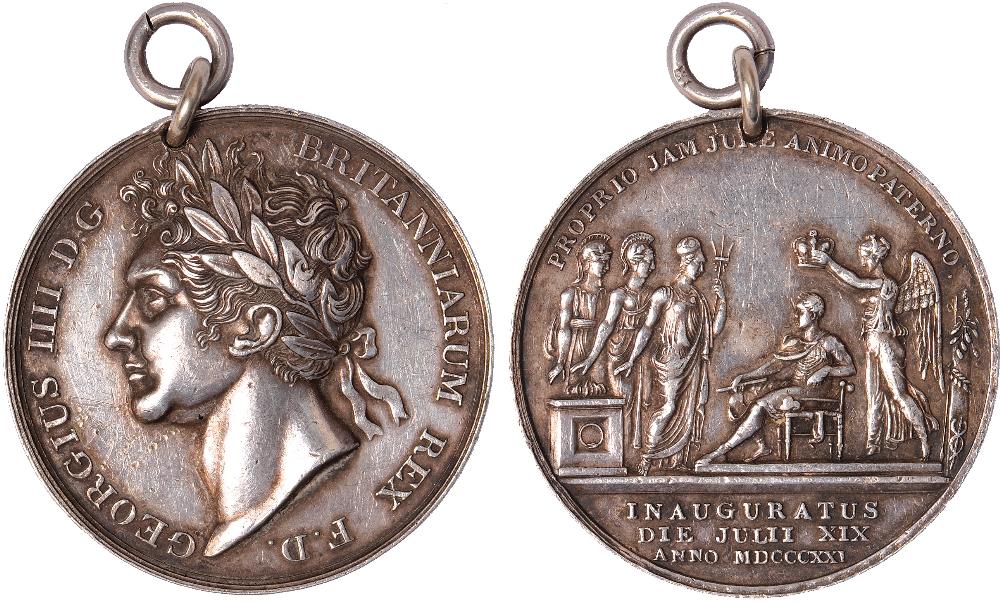Designed by Edward Avern, the silver medal was commissioned by the Lord Lieutenant, Richard, 2nd Marquess of Buckingham, soon to become the 1st Duke of Buckingham and Chandos. It was issued to all those members of the 1st (Southern) and 2nd (Mid Bucks) Regiments of Bucks Yeomanry Cavalry on duty in London for the coronation of King George IV from 15-22 July 1821. The obverse bears the King’s head and Georgius IIII D. G. Britanniarum Rex F.D. (‘George IV, by the Grace of God, King of the British, and Defender of the Faith’). The reverse shows the seated King being crowned by a winged figure with Britannia, Scotia and Hibernia approaching from the left. The motto to the top is Proprio Jam Jure Animo Paterno (‘Now in His Own Right with His Father’s Mind’). To the bottom, Inauguratus Die. Julii XIX Anno MDCCCXXI (‘Inaugurated July 19 1821’). The recipient’s name was inscribed on the edge. The medals were pierced for a ring and a ribbon attached so that the medal could be worn as a decoration on grand field days and state occasions. In form, the medal closely resembled the official coronation medal designed by Benedetto Pistrucci, the principal engraver and chief medallist of the Royal Mint. George IV apparently disliked the depiction of himself on the same level as the allegorical representations of his kingdoms.
The King’s coronation came at the height of his unpopularity over his treatment of his estranged wife, Caroline of Brunswick, who he had attempted to divorce through a public trial before Parliament. Barred from the coronation, Caroline was famously turned away from the doors of Westminster Abbey on 19 July. She died on 7 August.
Anticipating popular unrest, troops were deployed ahead of the coronation. The services of the Bucks Yeomanry were offered in June 1821. Men from the 2nd Regiment were concentrated at Great Missenden, Amersham and Chesham on 15 July. All marched two days later to Watford before proceeding to Cumberland Gardens, Vauxhall. Two troops were billeted in Wandsworth, one between Wandsworth and Battersea, two at Battersea, and three between Lambeth and Vauxhall. The headquarters were in Cumberland Gardens. Those from the 1st Regiment were based in Kensington. All had been enjoined to ‘act with the greatest coolness, prudence, and forbearance, and under no circumstances whatever, to presume to act with severity without the orders of a Magistrate, or some other Peace Officer duly authorised to give them such orders’. Patrols of the 2nd Regiment – usually of an officer and 12 men – were mounted over Vauxhall Bridge and along Millbank Street, and along Vauxhall Road to its junction with Chelsea Road, the roads to be kept clear. After the coronation on 19 July and an inspection by the Duke of York in Hyde Park, the regimental contingents marched back to the county on 22 July.
It was denied that some men of the 1st Regiment had broken away from the review to escort Queen Caroline’s passing carriage. Apart from commissioning the medal, the 2nd Marquess rewarded those of his tenants who had done coronation duty and ‘suffered much inconvenience, by absenting themselves from their farms at so busy a time’ by suspending payment of rents due at Michaelmas until the following Lady Day.
At least 38 of the medals are held in various collections, 22 for members of the 1st (Southern) Regiment and 16 for members of the 2nd (Mid Bucks) Regiment. BMMT holds those of Sergeant Major Richard Boncey (1st Regiment), John Leeson (2nd Regiment), Lieutenant William Lucas (2nd Regiment), and James Webb (1st Regiment).
